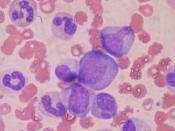Brown spots on Mary's skin
The ABCD rule is:
* A is for ASYMMETRY: One-half of a mole or birthmark does not match the other.
* B is for BORDER: The edges are irregular, ragged, notched, or blurred.
* C is for COLOR The color is not the same all over, but may have differing shades of brown or black, sometimes with patches of red, white, or blue.
* D is for DIAMETER: The area is larger than 6 millimeters (about ü inch -- the size of a pencil eraser) or is growing larger.
Superficial spreading melanoma can, in many cases, be recognized as an extension of the abnormalities noted in dysplastic nevi. Its features include Asymmetry, irregularity of Border, Color variation, and large Diameter. These ABCD rules can be useful, but many melanomas are not identified using them. For instance, the D of ABCD includes a lesion diameter greater than 6 mm in diameter.
Thanks to an educated physician and general public, melanomas in Australia are diagnosed smaller than 6 mm 60 percent of the time. Thus size alone is not a useful predictor, unless the lesion is large. Similarly, edge and color variation are common in very tiny new nevi that are not dysplastic. As nevi evolve beyond 2 to 4 mm, the variation becomes less and less in the normal nevus. Conversely, the irregularity of edge and color can be accentuated in the dysplastic nevus evolving into a melanoma.
Thus, while the ABCD rule is useful as a way of thinking about morphology, strict adherence to it may result in the missing of some melanomas.
Case # 2 [Fractured Tibia of Johnny]
Long Bone has a rich vascular supply. It receives 10-20% of the cardiac output. Blood supply varies with different types of bones. Blood vessels are...


